- Automation
- Home
- /
- Learning Hub
- /
- What is End-to-End Testing?
- -
- December 11 2023
What is End-to-End Testing?
A comprehensive end-to-end testing tutorial that covers what E2E testing is, its importance, and how to perform it.
OVERVIEW
End-to-end testing, also known as E2E testing, validates a software application's workflow from start to finish from the user's perspective, ensuring all integrated components and dependencies function as intended. With E2E testing, developers and testers can identify defects during the interaction of different application components, ensuring overall functionality, reliability, and performance.
Considering the increasing intricacy of modern software applications, end-to-end testing plays a critical role. The modern software applications often involve multiple components interacting simultaneously, which can lead to challenges even if each component functions perfectly on its own.
This complexity arises from potential miscommunications between these components. Therefore, end-to-end testing becomes essential in ensuring the smooth flow of information within the Application Under Test (AUT).
Testers aim to achieve thorough coverage through end-to-end testing. This means that they want to test all components of the software application, including the user interface, application server, database, and any external systems the software application uses. By this approach, they ensure everything works as expected.
What is End-to-End Testing?
End-to-end testing is essentially the process of ensuring that your software application functions seamlessly from the moment a user starts using it until they reach the end of their intended actions.
It's mimics how real users will interact with the software application to make sure everything runs smoothly. This comprehensive testing approach evaluates the software from the user's standpoint to confirm that all the components work in sync as they should. Typically, end-to-end testing happens after integration testing and right before the software is ready for release.
Performing complete user workflow checks in end-to-end testing is more thorough than unit testing or integration testing methods. Typically, this involves running the software application with all potential dependencies, such as the database, external services, performance metrics, logging, and so on. This helps in replicating real-world scenarios as closely as possible.
In an ideal end-to-end testing scenario, you validate all components and dependencies instead of only a specific set of features, as in integration testing. End-to-end testing can be conducted manually by human testers or through automated scripts.
To know how end-to-end testing differs from integration testing, check out this article on end-to-end testing vs integration testing.
Why is End-to-End Testing Important?
Modern software applications are complex, with multiple components and dependencies. This complexity can lead to unpredictable issues, especially when different systems interact. To ensure quality, it's crucial to test how the end user experiences the final application, including all its components and dependencies. This means running tests that cover everything from simple actions to complex workflows.
These tests mimic user behavior, which can be observed during usability testing. They help find issues before releasing the product to users and assist product managers in setting priorities for development tasks. End-to-end testing also improves the user experience by creating test cases with user expectations, especially for software applications that require a lot of user interaction, like web and desktop apps.
Advantages and Disadvantages of End-to-End Testing
The end-to-end testing approach offers various benefits in ensuring that software applications meet user expectations, perform as expected, and handle real-world scenarios effectively. However, it is essential to consider the potential challenges associated with E2E testing, such as execution time, maintenance overhead, and others.
Advantages:
- User-Centric Approach: It focuses on the user's perspective, ensuring the software application meets user expectations and requirements. It validates that the application is easy to use, intuitive, and provides a positive user experience.
- Comprehensive Testing: E2E testing covers the entire application workflow, from user interactions with the UI to the interactions between different components and systems. This comprehensive approach helps identify integration issues and ensure that the application functions seamlessly as a whole.
- Early Bug Detection: It helps identify and fix bugs early in the development cycle, reducing the cost and effort of fixing them later. By simulating real-world scenarios, E2E testing can uncover bugs that might not be detected by unit or integration tests.
- Improved Reliability: It enhances the overall reliability of the software application by validating its performance and robustness under various conditions. It helps ensure the application can handle different usage patterns, workloads, and potential failures.
- Increased Test Coverage: As E2E tests sit at the top of the testing pyramid, they contribute significantly to the overall test coverage of the application. They help ensure that the application is tested from a holistic perspective, covering both individual components and their interactions.
Disadvantages:
- Execution Time: E2E tests can be time-consuming to execute, especially for large and complex applications. They often require significant setup, data preparation, and test execution time.
- Maintenance Overhead: It requires ongoing maintenance to keep up with changes in the application, its environment, and user requirements. As the application evolves, E2E tests need to be updated and adapted to maintain their effectiveness.
- Root Cause Analysis Difficulty: When E2E tests fail, it can be challenging to identify the root cause of the issue. The complex nature of E2E tests, which involve multiple components and interactions, can make pinpointing the exact cause of a failure more difficult.
- Dependency on External Resources: E2E tests may rely on external resources, such as third-party APIs or databases, which can introduce additional complexity and potential failures. Ensuring the availability and stability of these external resources is crucial for E2E testing success.
E2E Testing Example
Now that we understand what is E2E testing, and its pros and cons, let’s understand with an E2E testing example.
Scenario: Customer purchases a product from the website, pays for it, and receives a confirmation email.
Objective: Verify that the entire purchasing process functions as expected.
Test Cases:
Product Selection:
- Verify that the product page displays correctly.
- Verify that the product selection feature works properly.
Customer Information:
- Verify that the customer information form validates data correctly.
- Verify that required fields are marked and cannot be left blank.
Payment Information:
- Verify that the payment information form validates data correctly.
- Verify that supported payment methods are listed and functional.
Payment Processing:
- Verify that payment processing is successful.
- Verify that payment gateway integration works seamlessly.
Order Confirmation:
- Verify that the website displays a confirmation message upon successful payment.
- Verify that confirmation email is sent to the customer's inbox.
Email Contents:
- Verify that the confirmation email contains the correct purchase details.
- Verify that the email format is consistent with website branding.
Order History:
- Verify that the purchase is reflected in the customer's order history.
- Verify that order details are accurate and up-to-date.
Component Integration:
- Verify that the shopping cart, payment, and email notification systems interact smoothly.
- Verify that data flows seamlessly between components.
Outcome:
- Validated the entire purchasing process from start to finish.
- Identified any potential flaws or inconsistencies in the user experience.
- Ensured that website components are integrated and functioning correctly.
- Improved the overall reliability and user-friendliness of the eCommerce platform.
What is the E2E Testing Life Cycle?
The end-to-end testing life cycle consists of several phases that ensure a comprehensive approach to testing an entire software application from start to finish—here are the key phases of the E2E testing life cycle.
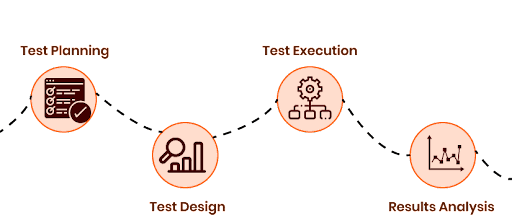
- Test Planning: Define test objectives based on customer requirements and application architecture after integration testing.
- Test Design: Set up the test environment, conduct risk and usage analysis, and create test cases, possibly using automation testing tools.
- Test Execution: Execute test cases, both locally and remotely, monitoring progress and consistency with the test plan.
- Results Analysis: Analyze test results, identify root cause of bugs, and relay findings to the development team for resolution.
End-to-End Testing Pyramid
Test pyramid is a software development framework that can foster high-quality code by minimizing the time required for developers to determine if changes affect the existing code. It also aids in developing a more robust test suite.
The testing pyramid is a model that provides a structure for the types of tests to be performed. It also defines the order and frequency of such tests. The purpose is to provide rapid feedback to ensure that code changes do not impact existing functionality.
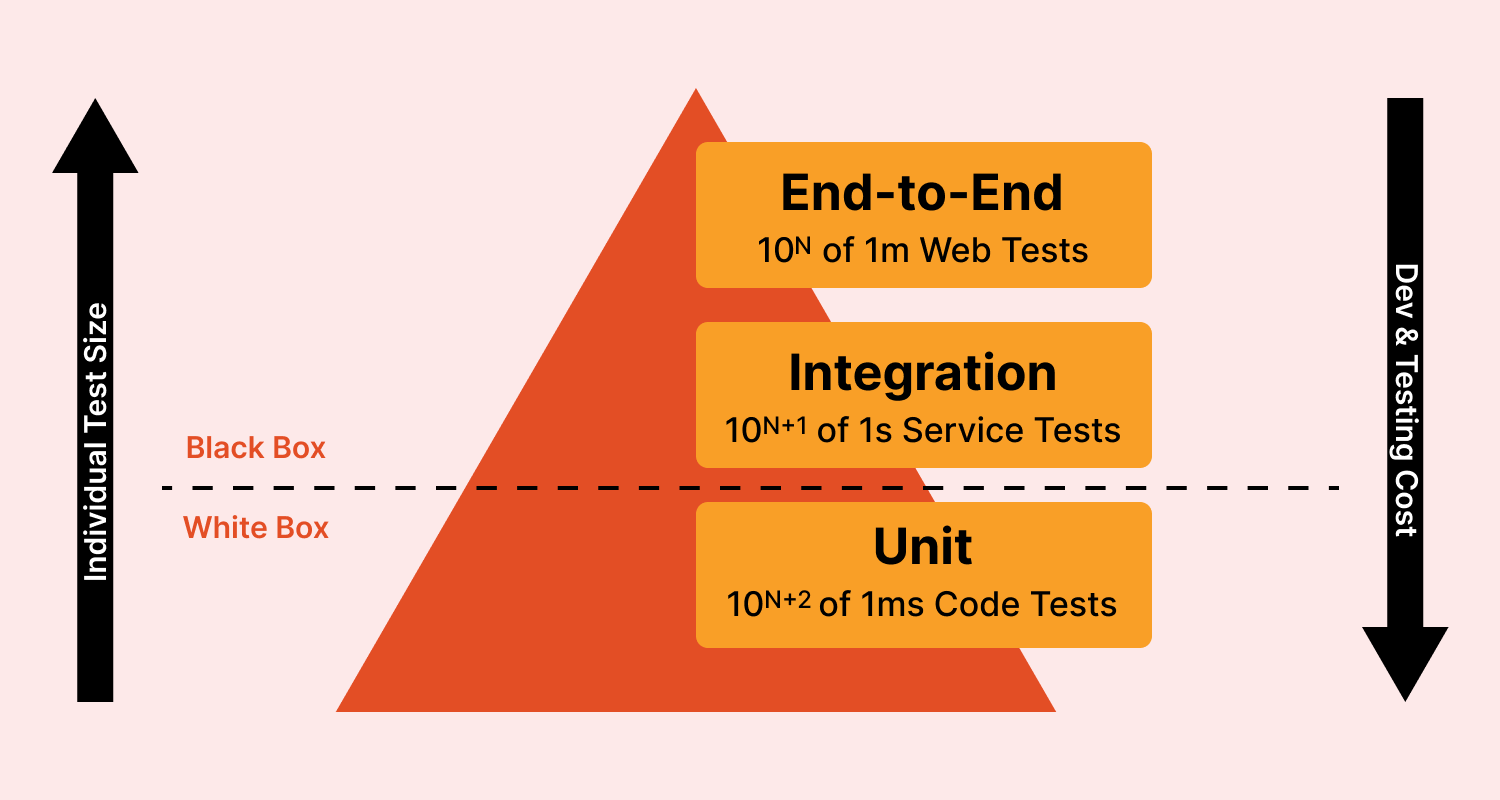
The test automation pyramid has three levels: unit tests, integration tests, and end-to-end tests.
- Unit Testing: It forms the base of the testing pyramid. These tests have a narrow scope, ensuring individual code units work correctly alone. Unit tests evaluate a single component and don't rely on external factors.
- Integration Testing: It is the second tier of the software testing pyramid. While unit tests check small components of the code, integration tests are performed by the development team to test how these parts interact with others in the software application.
- End-to-End Testing: End-to-end testing checks a large part of the code. It uses a test environment and data to mimic real-world environments. It's the most resource-intensive and slowest phase. Due to its extensive scope, finding issues here can be challenging.
In this pyramid layer, the team conducts both pre-commit and post-commit tests, with developers triggering them. Using virtual devices like simulators and emulators for these tests is highly recommended. They provide feedback quickly and cost-effectively.
These tests check how the code interacts with external components like external services (APIs), databases, web services, and more. Integration tests ensure that the software communicates well and retrieves accurate data—integration tests are usually slower due to their interaction with external sources and require a pre-production environment.
The best approach to end-to-end testing is to think like an end user. Testers consider how users may interact with the app, their aims, and potential issues to create test cases based on these actions.
End-to-end testing is at the top of the test automation pyramid and is typical the most time-consuming phase. It may also rely on less reliable external dependencies, like integration tests. Using real devices that simulate physical smartphones is crucial here since real users encounter issues on real devices, not virtual ones.
Types of End-to-End Testing
End-to-end (E2E) testing plays a crucial role in ensuring the functionality and performance of an entire software application from the user's perspective. This comprehensive testing approach simulates real-world user scenarios and covers various components and interfaces to verify the smooth flow of the application.
Two primary ways to perform E2E testing are horizontal and vertical testing, each with its advantages and disadvantages.
- Horizontal E2E Testing: This approach concentrates on ensuring individual workflows function correctly from the user's perspective. It verifies user-facing aspects of the software application, such as product search, ordering steps, and shipping details.
- Vertical E2E Testing: This approach takes a more technical perspective, delving deeper into the application's backend functionality. It focuses on verifying the smooth flow of data between components and ensuring background processes function seamlessly. Also, it involves testing features like account registration, product database updates, and UI functionalities in a sequential manner.
Layers Involved in E2E Testing
In end-to-end testing, you test all layers or components of an application - from the user interface (UI) to the database. The following are some of the layers involved in E2E testing:
- Presentation Layer: The presentation layer is the user interface of an application, including elements such as buttons, forms, and menus. E2E testing of the presentation layer involves testing these UI elements' functionality, performance, and usability.
- Application Layer: The application layer is part of the software application that deals with processing data and coordinating the different components of the software application. E2E testing of this layer will help ensure that your application logic functions correctly, is secure, and performs well.
- Integration Layer: The integration layer is the connection point between various software application components. This layer may comprise APIs, web services, or other interfaces. E2E testing of the integration layer involves testing the functionality and compatibility of these interfaces and their performance.
- Data Layer: The data layer includes the application's database and data storage components. To test these components, you must test the database and data storage components' functionality, performance, and security.
E2E Testing Checklist
E2E is not just about testing the user interface because a user interface is made of numerous distinct components. For example, the website's content may be fetched from a database via an API. Therefore, the front-end design, the database, and the API must be tested independently and in conjunction in this situation.
To ensure comprehensive E2E testing, consider the following checklist:
- Database: Verify that the database functions as intended, including data storage, organization, retrieval, and updates.
- Performance: Check page loading speed and overall system responsiveness, as these factors significantly impact user experience.
- Security: Use vulnerability testing tools to evaluate the application's resilience against potential security breaches.
- Functionality: Ensure that all features function as expected. Run unit tests where applicable to thoroughly test individual components.
- Usability: Evaluate the user experience by testing element interactions like clicks, navigation flow, and overall ease of use.
Metrics to Use in End-to-End Testing
In end-to-end testing, measuring and tracking various QA metrics is important to track your testing efforts and ensure your software application works as intended. Here are some of the most commonly used metrics in end-to-end testing:
- Test Coverage: It is a metric that indicates how thoroughly your tests have been tested. Achieving high test coverage is essential to identify defects and thoroughly test all critical functionalities.
- Test Cycle Time: Test cycle time is the amount of time it takes to complete a test cycle, including planning, execution, and reporting. Keeping test cycle time short ensures that the system is tested frequently, enabling any issues to be identified and resolved quickly.
- Defect Density: The defect density metric measures the number of defects found per unit of code or functionality and can help identify areas that need improvement. This information can help allocate resources to fix the issues identified.
- Error Rate: The error rate measures the percentage of test cases that failed during testing. A high error rate can indicate problems with the software and suggest further testing is needed.
- Test Case Effectiveness: Test case effectiveness measures the number of defects found in the system by a test case. This helps evaluate the quality of the test cases and identify areas where additional testing is required.
- Test Environment Stability: This metric measures the stability of the test environment, including the hardware, software, and network infrastructure. Stable testing conditions ensure that your results are accurate.
End-to-End vs. System Testing
Let's look at the detailed difference between end-to-end and system testing.
| End-to-End Testing | System Testing |
|---|---|
| End-to-end testing includes testing the behavioral workflow of the software application. | System testing includes testing the software application as a whole. |
| The focus is to test based on user experience and business requirements. | Technical aspects of the software/application are only tested. |
| Usually performed by testers who are familiar with user experience. | Usually performed by testers who are not involved in the development process. |
| It includes regression testing, integration testing, and user acceptance testing. | It includes functional testing, performance testing, security testing, and usability testing. |
| It helps in validating the interfaces of the software application. | System testing validates the software system's compliance with standards, specifications, and other requirements. |
| It is usually performed manually. | Performed both manually and automated. |
End-to-End vs. Functional Testing
Both end-to-end and functional testing are crucial components of software quality assurance. While they share some similarities, they have different focuses and objectives. Here's a breakdown of their key differences:
| End-to-End Testing | Functional Testing |
|---|---|
| Evaluates the software application as a whole, including all components, subsystems, and dependencies. | Focuses on verifying specific functions or features of the software application in isolation. |
| Ensures that all integrated parts of the software work seamlessly together and that the application delivers the expected output. | Ensures that individual functions or features of the software application meet their intended purposes and function correctly. |
| Generally more complex and time-consuming due to testing the complete application workflow. | Typically, it is less complex because it isolates specific features for testing. |
| Provides extensive coverage by testing the application across different layers and interactions. | Offers targeted coverage by testing specific functionalities or features. |
| It often involves simulating user behavior, using real or simulated data, and testing the software under various conditions to mimic real-world scenarios. | It usually requires black-box testing, where testers examine the software's behavior based on input and expected output without considering the internal workings. |
End-to-End Testing Frameworks and Tools
Several frameworks and tools are available for performing end-to-end (E2E) testing, each offering different features and benefits. Here are some of the most popular options:
- LambdaTest: LambdaTest is an AI-powered test orchestration and execution platform that helps businesses drastically reduce time to market through faster test execution and quality releases. With the LambdaTest platform, you can perform real-time and automation testing at scale across 3000+ environments and real mobile devices.
- Selenium: Selenium is an open-source suite of tools and libraries for automating web applications. It controls web browsers programmatically, simulating user actions and testing across platforms and browsers. It supports various languages, frameworks, and browsers and can record and playback user interactions. With Selenium, you can improve test coverage and consistency and support CI/CD pipelines.
- Playwright: Playwright is an automation framework that helps you perform end-to-end and cross browser testing for modern web applications. Its options include taking a screenshot of the entire page or a specific element on the page. In addition to saving the screenshot, you can get a buffer with the image and post-process it. While performing Playwright end-to-end testing, if an E2E test fails, the page screenshot will be handy for determining what went wrong and fixing it.
- Cypress: Cypress is a modern, browser-based framework for end-to-end testing of web applications. It offers a user-friendly experience with a built-in test runner, time travel debugging, and automatic screenshot capture for failures.
- Puppeteer: Puppeteer is a browser automation framework built on top of Chromium's DevTools Protocol, a protocol for communicating with browsers from user scripts. It lets you run headless Chrome in Node.js to perform most tasks a developer performs when debugging, such as handling requests and responses, locating elements, network traffic, and so on.
You can also Subscribe to the LambdaTest YouTube Channel for tutorials around Selenium testing, automation testing, Appium, and more.
For test automation, LambdaTest integrates with a wide range of automation testing frameworks, including Selenium, Cypress, Playwright, Puppeteer, Taiko, Appium, Espresso, and XCUITest.
End-to-end testing with Cypress is the go-to choice for testing the integration between two or more systems. Doing so can ensure that various dependencies of an application are working accurately and that accurate information is being communicated between multiple system components.
With Puppeteer, no special configuration is needed to get started. When you download Puppeteer, it installs its version of Chrome. But if you prefer to use a browser you already have installed, you can install the puppeteer-core package.
How to Create End-to-End Test Cases?
To create an effective end-to-end (E2E) test cases, here’s a roadmap to guide you through the process:
- Define the User Journey: Start by outlining the primary user journeys within your application—these journeys represent the key functionalities users expect to perform and the steps involved. Also, identify each critical touchpoint and interaction within each journey. This can include login, registration, product search, purchase, account management, and so on.
- Analyze Requirements and Specifications: Thoroughly review the application's requirements and specifications documents. This will provide a clear understanding of the expected behavior and functionality.
- Prioritize Test Cases: Not all test cases are identical. Prioritize testing critical functionalities and user journeys that are most impactful and frequently used. Utilize risk-based analysis to identify areas with higher potential for bugs or failures.
- Incorporate Automation Tools: Consider automating repetitive test cases to save time and effort. Use automation testing tools like Selenium, Cypress, and Appium can streamline E2E testing and improve overall testing efficiency. Automation frees your time to focus on more complex and exploratory test scenarios.
- Maintain and Update Test Cases: As your application evolves and features are added, remember to update your E2E test cases accordingly. Regularly review and refine existing test cases to ensure they remain relevant and effective.
- Collaborate and Communicate: Collaborate with developers and stakeholders during the E2E test case design process. This ensures everyone understands the testing objectives and methodology. Communicate test results and any identified bugs clearly and promptly to facilitate timely resolution.
How to Perform End-to-End Testing?
End-to-end testing is a complex process that requires proper planning and coordination between the development and testing teams. You can follow these steps to ensure your system meets the requirements and functions correctly.
- Requirement Gathering: The first step in end-to-end testing is to gather requirements. This involves understanding the scope of the software application, its features and functionality, and how they'll be tested.
- Test Planning: The next step is to plan, which involves creating the test cases that will be used to evaluate its performance. This includes defining the test scenarios, identifying the test data, and creating the test cases.
- Test Environment: To ensure that your end-to-end tests are effective, you need to set up a test environment that mimics the production environment. Setting up a test environment for end-to-end testing requires installing and configuring hardware, software, and network infrastructure.
- Test Execution: Once the test environment is set up, you can run the test cases to simulate real-world usage scenarios. Running these test cases helps identify defects or issues that need to be fixed.
- Defect Resolution: After identifying defects, the development team fixes them and re-tests the system to ensure they have been resolved.
- Test Reporting: Test reports are essential to provide transparency and help stakeholders understand the software's overall performance and any issues found during testing.
When it comes to E2E testing, there are two options: testing on a local machine or conducting tests in the cloud. Each approach has its own set of advantages and disadvantages.
Opting for local machine testing gives you control over the testing environment. This means teams can customize the infrastructure and tools according to their specific requirements. Therefore, testing cycles become faster due to reduced network latency. However, this approach may require more resources to handle larger scenarios and is expensive.
On the other hand, cloud-based testing offers virtually limitless resources and scalability without hardware limitations. This method is cost-effective as teams only pay for the resources they need.
End-to-End Testing on the Cloud
E2E testing in the cloud is testing websites and mobile applications on cloud-based servers. Using a cloud-based platform offers several advantages that streamline the testing process. One such benefit is scaling up or down the testing environment based on specific requirements. Additionally, accessing the web or mobile application from any location with an Internet connection promotes remote collaboration, enabling teams to work seamlessly across different geographic locations.
AI-powered test orchestration and execution platforms like LambdaTest offer end-to-end (E2E) testing in the cloud. It allows you to perform manual and automation testing across a wide range of real browsers, devices, and operating systems.
Moreover, LambdaTest integrates seamlessly with popular automation testing frameworks such as Selenium, Cypress, Playwright, Appium, and more. This integration lets users conduct automated tests on a secure, scalable, and reliable automation cloud platform.
LambdaTest offers two E2E testing approaches: real-time (manual) and automated testing.
Real Time Testing
Step 1: Sign up for a free LambdaTest account and log in.
Step 2: From the user Dashboard, go to Real Time from the left sidebar menu.
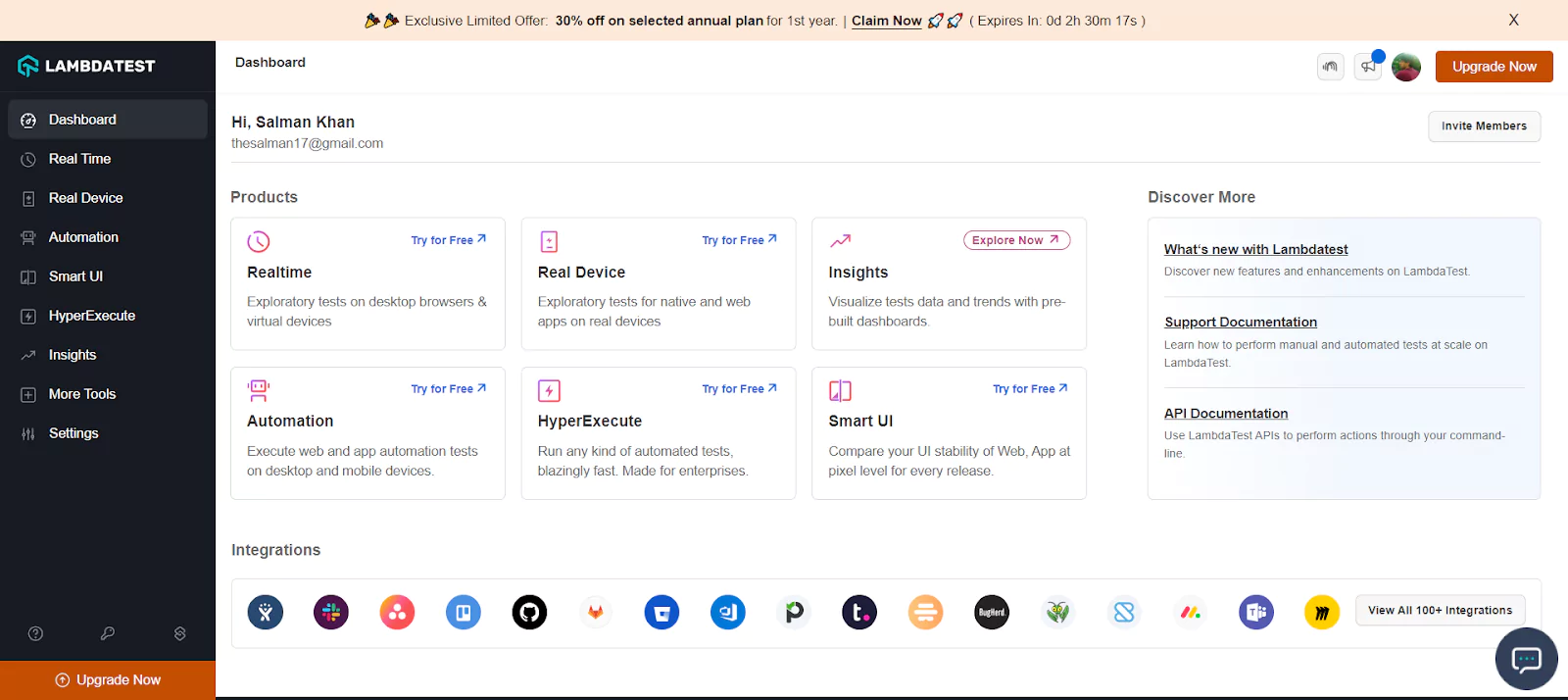
Step 3: It will land you on to the Browser Testing console.
Step 4: Enter the URL that you need to test. Select your desired browsers, versions, OS, and resolutions. Then click on START.
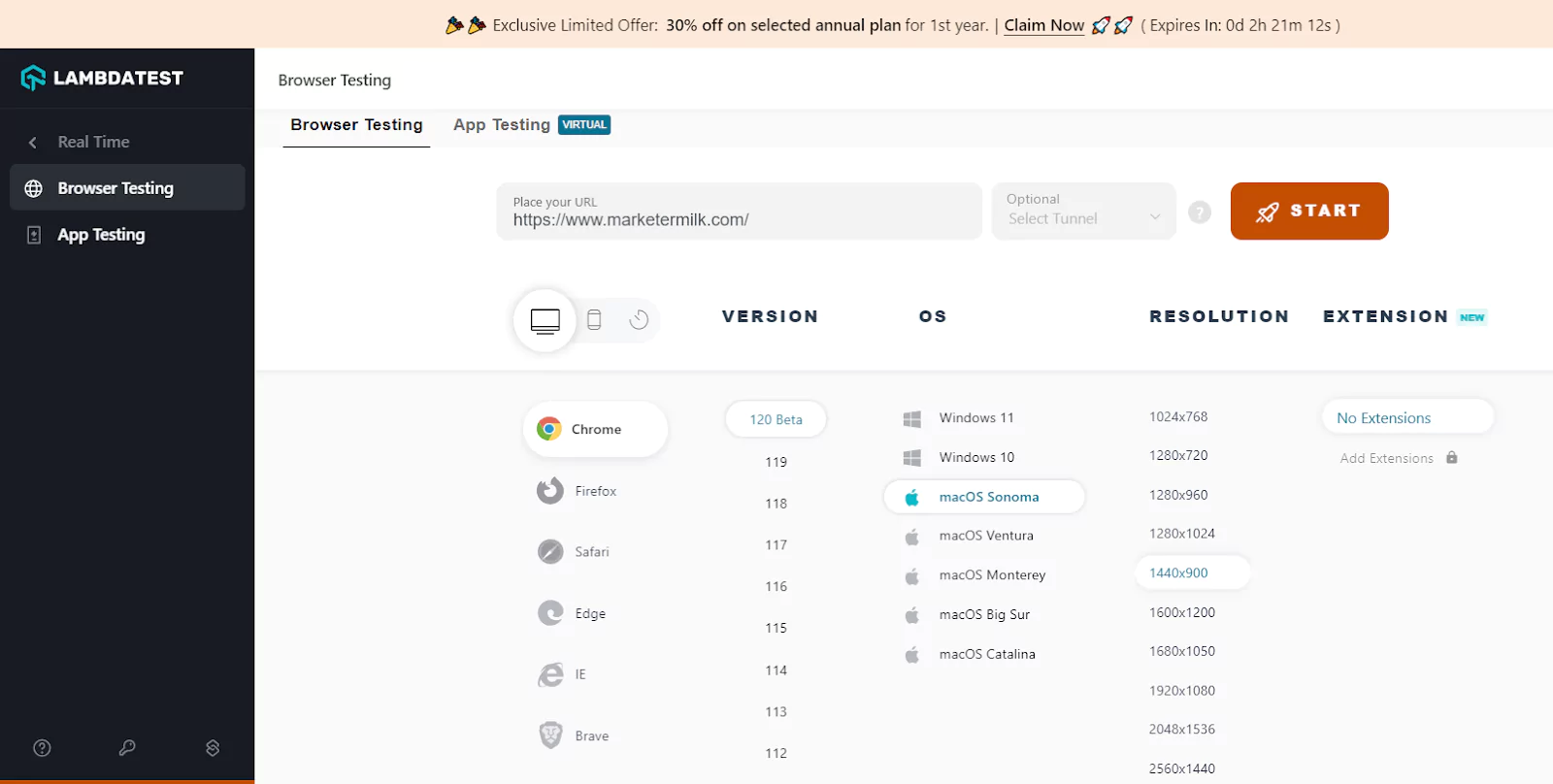
This action will launch a cloud-based machine for conducting E2E testing based on your specified configuration.
Automation Testing
LambdaTest online Selenium grid offers access to over 3000 desktop environments. You can also run automated tests using frameworks like Selenium, Cypress, Playwright, and more.
Here's how to perform automation testing on the LambdaTest platform:
Step 1: Follow the same login process as mentioned earlier.
Step 2: Navigate to the Automation > Web Automation from the in the left menu, which provides options for Demo Project or Configure Test Suite.
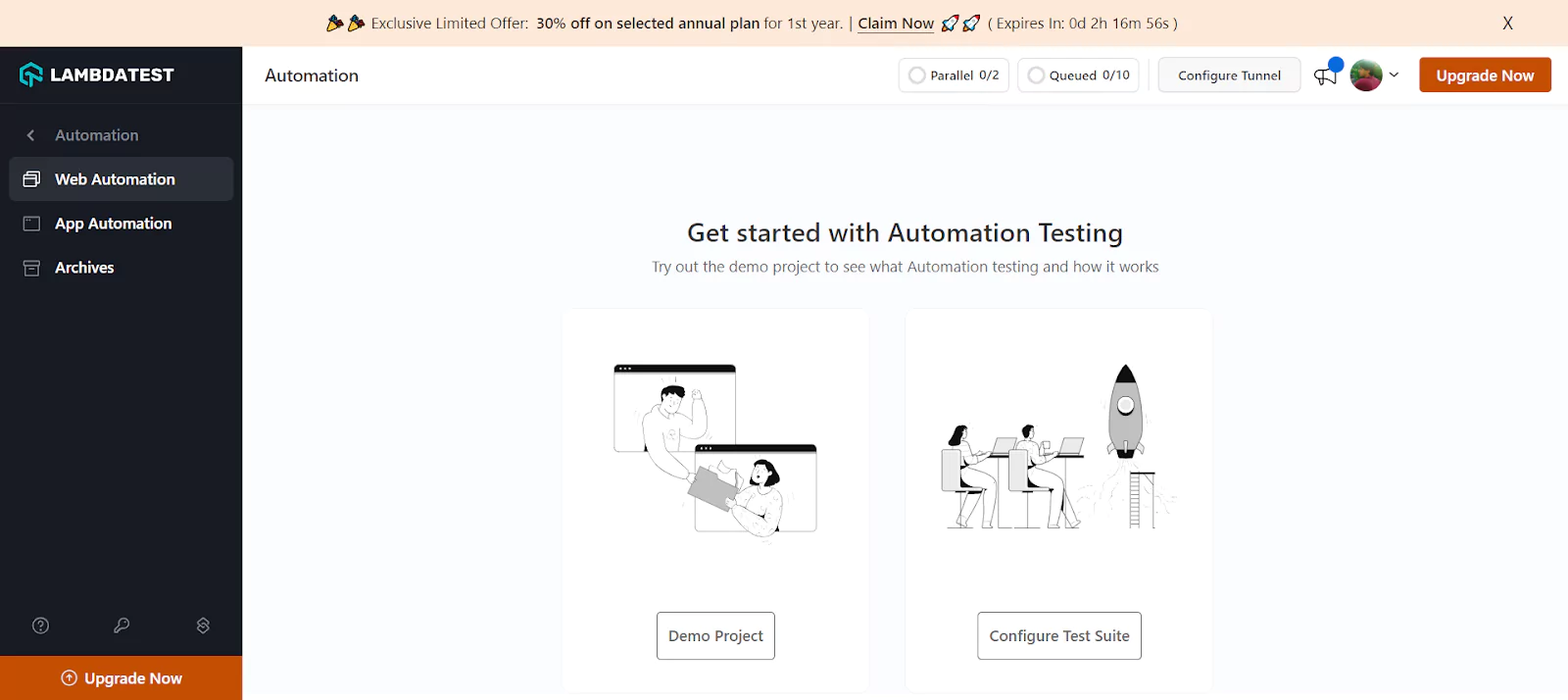
Step 3: Choose Configure Test Suite to set up and run your tests with your preferred automation testing framework.
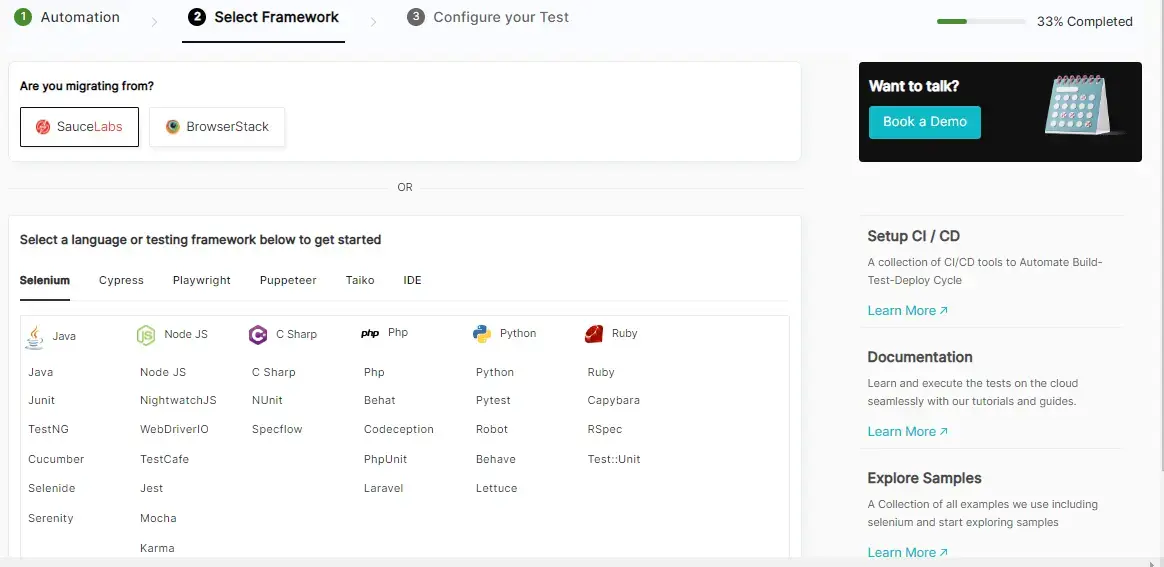
Step 4: Configure your test settings and start your automation testing process.
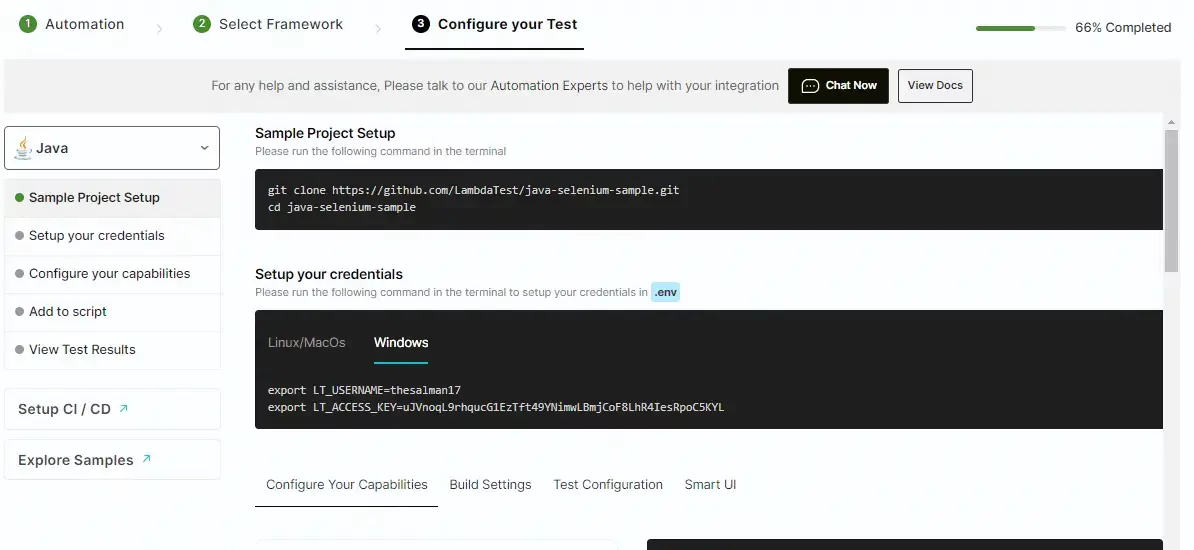
Challenges with End-to-End Testing
End-to-end testing has several advantages, but some present some challenges discussed below.
- Test Flakiness: This occurs when an E2E test fails intermittently, even though the same steps and conditions are used. This can be frustrating for developers and testers, as it wastes time and resources investigating and debugging these unreliable tests. Causes of flakiness can range from external dependencies like network issues to complex test scripts with intricate interactions.
- Sluggish Test Execution: E2E tests often involve simulating real-user interactions across various components of the software application. This can lead to slow execution times, especially for complex applications or when dealing with large datasets. This slowness can make it challenging to run tests frequently and can delay feedback loops, impacting overall development speed.
- High Maintenance: Maintaining E2E tests can be time-consuming and resource-intensive. As software applications evolve, tests need to be updated frequently to reflect changes and remain relevant. This can be a significant burden for teams, especially with limited resources.
- Gathering Actionable Insights: E2E tests often generate extensive reports with detailed information about failures. However, extracting actionable insights from these reports can be challenging. Teams need to sift through data and analyze various factors to identify the root cause of failures and determine effective solutions.
- Demonstrating Value: While E2E testing provides valuable benefits, quantifying its impact and demonstrating its worth can be difficult. This can lead to skepticism and reluctance to invest in further development and optimization of the E2E testing process.
To overcome this, developers and testers can leverage end-to-end test orchestration clouds like HyperExecute to execute their test suites at a blazing speed that is up to 70% faster than traditional cloud grids.
End-to-End Testing Best Practices
End-to-end testing is the type of testing that mimics the experience of a real user using the application. Here are a few best practices to get the best out of end-to-end testing:
- Focus on the Most Common Scenarios: Instead of covering every test case, prioritize the common user journeys and interactions. This ensures your testing efforts are focused on areas that genuinely impact user experience and business goals. Also, remember that integration and low-level unit testing are better suited for handling edge cases.
- Prioritize Business-Critical Features: Start by testing features that have a significant impact on your business, whether its user acquisition, engagement, or revenue generation. This ensures you address critical issues first and optimize your testing resources effectively.
- Mirror Real-World Usage: People don't just click buttons and move on. They read, pause, interact with content. Your end-to-end tests should reflect this realistic usage pattern to identify potential usability issues and ensure a smooth user experience.
- Leverage API Testing: Combine end-to-end tests with API tests to pinpoint the source of failures. This helps identify whether an issue originates from the front-end or the API, leading to faster and more efficient debugging.
- Cloud-Based Testing Environments: Choose a cloud-based testing environment that minimizes setup time and buying additional resources. This ensures you can run tests quickly and efficiently.
Conclusion
End-to-end testing is essential for assessing user interaction with your software applications. Evaluating the user experience from beginning to end provides more assurance regarding the quality of your application than simply testing if a button function or a model appears.
By implementing a well-defined end-to-end testing strategy, you can significantly improve the quality of your software and deliver a superior user experience. This comprehensive guide has provided you with a solid understanding of end-to-end testing concepts, implementation methods, and available resources.
On this page
- Overview
- What is End-to-End Testing
- Why is End-to-End Testing Important
- Advantages and Disadvantages
- E2E Testing Example
- What is the E2E Testing Life Cycle
- End-to-End Testing Pyramid
- Types of End-to-End Testing
- Layers Involved in E2E Testing
- E2E Testing Checklist
- Metrics to Use
- End-to-End vs. System Testing
- End-to-End vs. Functional Testing
- End-to-End Testing Frameworks and Tools
- Creating End-to-End Test Cases
- How to Perform
- End-to-End Testing on the Cloud
- Challenges with End-to-End Testing
- End-to-End Testing Best Practices
- Frequently Asked Questions (FAQs)
Frequently asked questions
- General
Author's Profile

Salman Khan
Salman works as a Digital Marketing Manager at LambdaTest. With over four years in the software testing domain, he brings a wealth of experience to his role of reviewing blogs, learning hubs, product updates, and documentation write-ups. Holding a Master's degree (M.Tech) in Computer Science, Salman's expertise extends to various areas including web development, software testing (including automation testing and mobile app testing), CSS, and more.
Reviewer's Profile

Shahzeb Hoda
Shahzeb currently holds the position of Senior Product Marketing Manager at LambdaTest and brings a wealth of experience spanning over a decade in Quality Engineering, Security, and E-Learning domains. Over the course of his 3-year tenure at LambdaTest, he actively contributes to the review process of blogs, learning hubs, and product updates. With a Master's degree (M.Tech) in Computer Science and a seasoned expert in the technology domain, he possesses extensive knowledge spanning diverse areas of web development and software testing, including automation testing, DevOps, continuous testing, and beyond.
Did you find this page helpful?
More Hubs
Try LambdaTest Now !!
Get 100 minutes of automation test minutes FREE!!

 Christmas Deal is on: Save 25% off on select annual plans for 1st year.
Christmas Deal is on: Save 25% off on select annual plans for 1st year.








